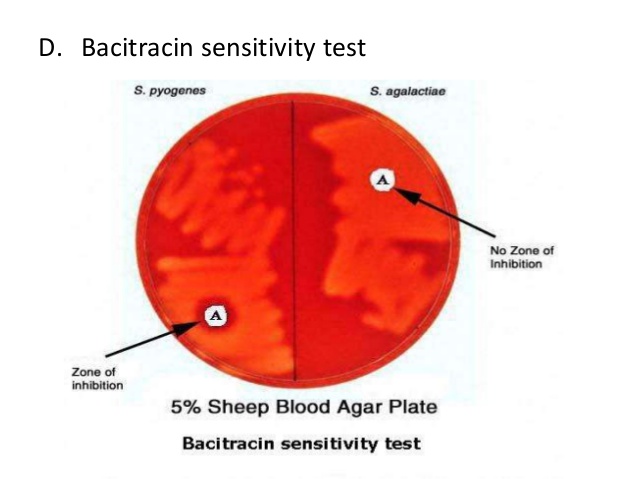
Principle:
- Bacitracin is the antibiotic produced by Bacillus licheniformis and this drug interferes the formation of peptidoglycan, a major component of bacterial cell wall. Bacitracin blocks bactoprenol from transporting NAM and NAG sugars across the cell membrane thereby halting further synthesis of peptidoglycan. Bacitracin test is usually performed for the presumptive identification and differentiation of beta-hemolytic group A streptococci (Streptococcus pyogenes– susceptible) from other beta-hemolytic streptococci. This test detects whether the organism is susceptible to bacitracin or not. It is also used to distinguish Staphylococci species (resistant) from micrococci (susceptible).
- A disk infused with a small amount of bacitracin (0.04 units) is placed on an agar plate, permitting the antibiotic to diffuse into the medium and halt the growth of sensitive organisms. Following incubation, the inoculated plates are analysed for zones of inhibition surrounding the disks.
- If there is a zone around the edge of the disk where the organism has not grown, the organism is sensitive to the bacitracin in the disk whereas if the organism grows up to the edge of the disk, it is resistant to the bacitracin infusing the disk.
Requirements:
- Test microorganism
- Blood agar (trypticase soy agar + 5% sheep blood)
- Inoculating loops
- Incubator
- Disk impregnated with bacitracin
Procedure of Bacitracin test:
- Use a sterile inoculating loop, select two or three suspect colonies of a pure culture.
- Streak the isolated colonies onto a blood agar.
- Using sterile forceps, place a bacitracin disk in the first quadrant (area of dense growth).
- Gently tap the disk to make sure appropriate contact with the agar surface.
- Incubate the plate for 18 to 24 hours at 35oC in ambient air.
- Observe zone of inhibition around disk.
Results interpretations:
- Positive test:
- If any zone of inhibition greater than 10mm is seen then the microorganism is susceptible to the antimicrobial compound infused in the disk and is suggestive of positive test.
- eg. Beta-hemolytic streptococci (Streptococcus pyogenes), Micrococcus
- Negative test:
- If no zone of inhibition is seen then the microorganism is resistant to the antimicrobial compound impregnated in the disk and it is indicative of negative test.
- eg. Streptococcus agalactiae, Staphylococcus

Limitations:
- An expired out blood agar plate should not be used because it decreases diffusion of the bacitracin yielding a false-negative result.
- Different concentrations of bacitracin results discrete zone sizes, thus differential disk (0.04 units) is used in comparison to sensitivity disks (10 units).
- When testing isolates, a light inoculum may result in false zone of inhibition. So it is important that an inoculum resulting in confluent growth be used.
- Different biochemical and/or serological tests such as latex agglutination are recommended on colonies from pure culture for complete identification.
